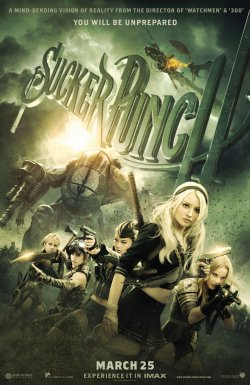Sucker Punch

Zack Snyder’s Sucker Punch is not by any means a great example of contemporary cinematic arts. If you’re looking for nuanced character studies and deeply engaging plotlines, well.. you did see the words “Zack Snyder” back there, didn’t you? This is the guy who brought us 300 and Watchmen, both of which look great and neither of which is any great dramatic shakes. And so Sucker Punch is a comic book movie freed from the burden of source material whose fans can be offended by its adaptation. It’s pure geek-culture id — the cinematic equivalent of Epic Mealtime.
The setup is simple: a woman dies, leaving her two daughters her entire estate. The girls’ stepfather is enraged and kills the younger one, placing the blame on the older one, and having her committed to an asylum in southern Vermont. He bribes a corrupt orderly to forge the psychiatrist’s signature and authorize a doctor — who will visit the facility in five days — to perform a trans-orbital lobotomy. The psychiatrist, for her part, is a proponent of a hazily-described form of therapy through acting and telling stories, and evidently has no idea what’s going on in what’s nominally her institution.
This backdrop, however, is quickly overlaid with a metaphor of sorts, and this is where most of the movie takes place. The asylum becomes a bordello; the orderly runs the place as Blue (Oscar Isaac); the psychiatrist is Madam Gorski (Carla Gugino); the inmates are dancers — including Amber (Jamie Chung), Blondie (Vanessa Hudgens), Rocket (Jena Malone), and Sweet Pea (Abbie Cornish), among others — whose dances take the place of their therapeutic storytelling; and the new girl is Baby Doll (Emily Browning), who is to be turned over to the “high-roller” when he comes in five days.
When Baby Doll starts her therapy — dancing, in the metaphor — it turns out that she entrances everyone watching. And it’s within these stories that much of the action occurs. She meets a mysterious wise man (Scott Glenn) who tells her that she can indeed gain freedom, and she enlists some of the other dancers in her plan for escape. Baby Doll will tell a story to preoccupy some observer while the others retrieve the necessary plot tokens that will play into the eventual escape: a map, a lighter, a knife, and a key.
The fantasy sequences, however, have only the loosest connection to either layer of “reality”, and I’ll be among the first to admit that they don’t make a lick of sense. But sense, of course, is not the point; awesome is. Five women with assault rifles and mecha battling German steampunk zombies across (and above) a bombed-out World War I hellscape is awesome; a frontal assault on an ork-filled castle and an aerial battle between a dragon and a B-25 bomber is awsome; a crawl along a futuristic train through an army of robotic gunmen to stop a bomb from destroying a city is awesome.
This being Zack Snyder’s work, the visuals are amazing. The CGI is not always more realistic than, say, a video game, but it definitely has a characteristically Snyderian look to it. The motion weaves together both the fight choreography and the (mostly virtual) camerawork elegantly. Marius De Vries and Tyler Bates have done excellent work with the soundtrack as well, packing it with remixes, mashups, and covers of some great music, often featuring the actual stars of the movie on the new vocals. Each of the six different settings has its own distinct look and sound, with its own color palette, editing style, music, and choreography. The whole thing has the feel of a playground for trying out different ways of spinning Snyder’s core movie making sensibilities.
All of which is a long way of saying, again, that this is a Zack Snyder movie, and so you really should know what you’re getting into already. If you don’t you have only yourself to blame. That said, I should also mention that there is, in fact, a sort of philosophical point to the script, but I really don’t think it’s worth addressing. For one thing, the position Snyder presents isn’t terribly deep, and is more of a jumping-off point for further discussion; for another, I’m pretty sure anyone who would actually admit that this aspect of the movie exists is already interested in seeing it on other grounds.
Oh, and one last thing: stay through the credits.
Worth It: yes, if you admit that there is an occasional place for bacon in a well-balanced diet.
Bechdel Test: pass.

Trackbacks